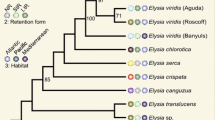Abstract
When the marine opisthobranchiate slug Hermaea bifida Mont. is incubated in a H14CO -3 -seawater medium in the light, a considerable net gain of 14C-assimilates is observed. Electron microscopic control provided evidence that this 14C-fixation is due to photosynthesis by chloroplasts (=rhodoplasts) endosymbiotic in the cells of the digestive gland of the slug. After thin-layer chromatographic analysis various 14C-labelled photosynthates could be traced. The assimilate pattern of the rhodoplasts is compared with that of the marine red alga Griffithsia flosculosa (Ellis) Batt., from which the plastids are acquired by feeding. The nutritional relationship of this endosymbiosis is discussed, with emphasis on the occurrence of functional chloroplast endosymbioses among the eolidiform species of the Sacoglossa.
Similar content being viewed by others
Literature Cited
Cornet, R. et J. Marche-Marchad: Mollusques. Trav. Stn biol. Roscoff Suppl. 5, 1–80 (1951)
Craigie, J.S.: Dark fixation of 14C-bicarbonate by marine algae. Can. J. Bot. 41, 317–325 (1963)
Droop, M.R.: Algae and invertebrates in symbiosis. Symp. Soc. gen. Microbiol. 13, 171–179 (1963)
Feige, B., H. Gimmler, W.D. Jeschke und W. Simonis: Eine Methode zur dünnschichtchromatographischen Auftrennung von 14C- und 32p-markierten Stoffwechselprodukten. J. Chromat. 41, 80–90 (1969)
Greene, R.W.: Sacoglossans and their chloroplast endosymbionts. In: Symbiosis in the sea, pp 21–27. Ed. by W.B. Vernberg. Columbia: University of South Carolina Press 1974
Hinde, R. and D.S. Smith: “Chloroplast symbiosis” and the extent to which it occurs in Sacoglossa (Gastropoda: Mollusca). Biol. J. Linn. Soc. 6, 349–356 (1974)
Kremer, B.P.: Photosynthetic carbon metabolism of chloroplasts symbiotic with a marine opisthobranch. Z. Pflanzenphysiol. (In press)
Muscatine, L. and R.W. Greene: Chloroplasts and algae as symbionts in molluscs. Int. Rev. Cytol. 36, 137–169 (1973)
Taylor, D.L.: The occurrence and significance of endosymbiotic chloroplasts in the digestive glands of herbivorous opisthobranchs. J. Physiol. 3, 234–235 (1967)
— Chloroplasts as symbiotic organelles in the digestive gland of Elysia viridis (Gastropoda: Opisthobranchia). J. mar. biol. Ass. U.K. 48, 1–15 (1968)
— Symbiosis between the chloroplasts of Griffithsia flosculosa (Rhodophyta) and Hermaea bifida (Gastropoda: Opisthobranchia). Pubbl. Staz. zool. Napoli 39, 116–120 (1971)
Trench, R.K., J.E. Boyle and D.C. Smith: The association between chloroplasts of Codium fragile and the mollusc Elysia viridis. III. Movement of photosynthetically fixed 14C in tissues of intact living E. viridis and in Tridachia crispata. Proc. R. Soc. Lond. (Ser. B) 85, 453–464 (1974)
Author information
Authors and Affiliations
Additional information
Communicated by O. Kinne, Hamburg
Rights and permissions
About this article
Cite this article
Kremer, B.P., Schmitz, K. Aspects of 14CO2-fixation by endosymbiotic rhodoplasts in the marine opisthobranchiate Hermaea bifida . Mar. Biol. 34, 313–316 (1976). https://doi.org/10.1007/BF00398124
Accepted:
Issue Date:
DOI: https://doi.org/10.1007/BF00398124




